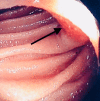Diagnostic and Therapeutic Benefits of Intra-operative Enteroscopy in Epithelioid Angiosarcoma of the Small Intestine
- PMID: 36824541
- PMCID: PMC9942692
- DOI: 10.7759/cureus.34056
Diagnostic and Therapeutic Benefits of Intra-operative Enteroscopy in Epithelioid Angiosarcoma of the Small Intestine
Abstract
Intestinal epithelioid angiosarcoma is an uncommon type of vascular tumor with unusually varied clinical presentations, including non-explained severe gastrointestinal bleeding, anemia, and abdominal pain. A 77-year-old man presented with recurrent severe anemia caused by gastrointestinal bleeding. The diagnosis was jejunal angiosarcoma. The patient had three intestinal resections assisted by explorative intraoperative enteroscopy, which detected multifocal intestinal lesions. Intraoperative enteroscopy is a helpful diagnostic and prognostic approach that detects small intestinal tumors. Intraoperative enteroscopy could improve the outcome of intestinal angiosarcomas.
Keywords: gastrointestinal bleeding; intestinal angiosarcoma; intestinal resection; intraoperative enteroscopy; sarcoma.
Copyright © 2023, Abdulfattah et al.
Conflict of interest statement
The authors have declared that no competing interests exist.
Figures






References
Publication types
LinkOut - more resources
Full Text Sources
